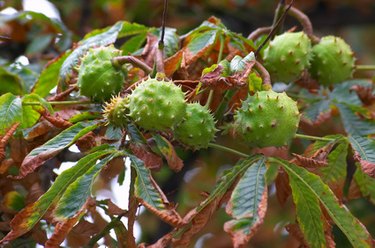
You won't have to worry about going hungry next time you're camping, hiking or just lost in the South Carolina wilderness. The state boasts many varieties of edible herbs, nuts and fruit. Of course, you should always be careful about consuming wild plants, but by recognizing the right characteristics and trying a small amount at a time, you can safely enjoy the native bounty of the Palmetto State.
Sassafras
Video of the Day
Sassafras grows to 30 to 40 feet in height. It has oval-shaped leaves and small, greenish-yellow flowers, but its most prominent feature is the fragrant odor of its leaves and bark. The roots are covered with a reddish gray husk that can be used for tea. Add the leaves to soups to give them a spicy flavor.
Video of the Day
Chickweed
Chickweed grows to about 2 1/2 feet tall and it has small, white flowers. The leaves and stems can be eaten raw or cooked in the same way you would with other leafy vegetables.
Small's Purslane
Small's Purslane is a rare plant with branching stems that reach about 4 inches in height. Its flowers are bright pink and oval-shaped. Interestingly, purslane leaves and stems taste similar to spinach when eaten raw, but when cooked, its texture is more like okra when cooked. It is also a good source of vitamins C and A.
Wintercress
Wintercress grows 1 to 4 feet tall. Its dark green, oval-shaped leaves grow in a spiral around the main stalk. Its flowers are small and yellow. Wintercress can be eaten raw, but it's advised to only eat up to one tablespoon chopped because the plant can absorb contaminates very easily. This is also why you should not eat wintercress that grows near the side of a road, waste areas or farms. That said, the leaves and flowers can be eaten cooked or fried. Winter cress is a good source of Vitamin C as well.
Hickory

There are two types of hickory trees found in South Carolina: mocker nut hickory and shagbark hickory. Mockernut trees grow to about 50 to 80 feet high in dry hillside areas. Shagbark grows 70 to 100 feet in the moist soil of lowlands and hills and true to its name, it features loose, curling bark. Both varieties have tapered compound leaves and both bear sweet-tasting nuts that resemble walnuts. In fact, hickory is a kind of walnut.
Chestnut

Like hickory, chestnuts are a kind of walnut. The trees grow in dry woods and reach heights of 5 to 15 feet. The round, spiky nuts can be eaten raw, roasted, boiled or grilled. Cut an x-shape into the nuts before boiling to reduce pressure.
Persimmon

Persimmon trees grow in lowland fields. They are usually 25 to 35 feet tall and produce white flowers and purple-orange fruit. These can be eaten raw. The fruit has a creamy texture and a mild tangy flavor.
Mulberry

Mulberry trees are found in moist lowlands. They can reach heights of 20 to 30 feet. They also produce long, oval-shaped leaves and clusters of small red, purple or white fruit. The berries can be eaten raw or cooked. Young, unopened mulberry leaves can be boiled and provide a mild flavor.
Partridge Berry
Also called teaberry, partridge berry is a forest shrub that grows to about 1 foot tall. Unlike most fruit-bearing plants, its bright red fruit often appears at the same time as its white flowers. Partridge berries can be eaten raw. The leaves and branches can be steeped in water to make tea. The berries, leaves and branches all have a minty flavor.
Wild Cranberry
Like their commercially harvested brethren, wild cranberries grow in bogs and marshes throughout the state. The plants grow 8 to 12 inches high and have pink flowers. The berries can be eaten raw or cooked.
Wild Grape

Wild grape vines in South Carolina are usually of the Fox grape variety. They typically grow in moist forest areas or river banks and have short, wide leaves. The purple-black fruit can be eaten raw, and its flavor is a more tart version of the common Concord grape.